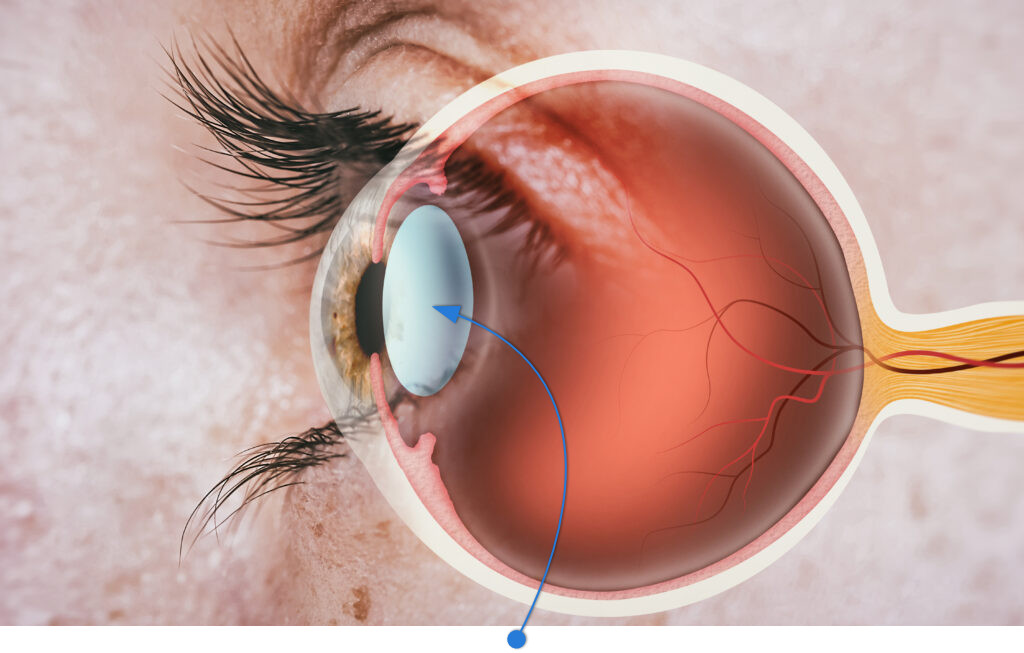Cataract surgery.
Cataracts are the most common cause of vision loss in people over 60 years of age. They are closely related to the aging of the crystalline lens, which is the natural lens of the eye that allows objects to focus and the passage of light to the retina. As the years go by, it begins to harden until it becomes opacified (loss of transparency), which we call a cataract.
This affects the visual health of the patient, who experiences blurred, cloudy vision or glare, as well as a progressive visual decrease, which is related to prescription changes. Color vision (color intensity) is also altered.
Currently, there is no pharmacological treatment, so the only definitive solution is a surgical intervention.

What is cataract surgery?
Cataract surgery consists of replacing the lens nucleus with a previously calculated intraocular lens. The calculation is preoperative and is performed taking into account various parameters of the patient’s eye.
What is the most used technique?
The most used technique to date is phacoemulsification with ultrasound. The fact that it is a minimally invasive technique facilitates a quick recovery. It is performed under topical anesthesia (drops in the eye during surgery), which does not require patients to stop taking their usual medication, since there is no bleeding during the intervention either.
What is the expected result after surgery?
In addition to returning clarity to the patient’s vision, one of the objectives of surgery is emmetropia, that is, the correction of the previous refractive error (need for glasses). For this, several types of implants or intraocular lenses are available. The design of intraocular lenses has evolved to simultaneously compensate for distance and near vision, in addition to astigmatism. Good patient selection is important, as well as a good lens calculation through previous preoperative tests.
How long does cataract surgery take?
Cataract surgery lasts only about 20 minutes. It is a very simple intervention, since it does not even require hospital admission. Only one eye is operated on in each session.

How does the eye look after cataract surgery?
After the intervention, the inflammation inherent to the surgery usually causes blurred vision in the patient for a few days, until the eye recovers with the help of a drop treatment.
What is cataract surgery?
Cataract surgery consists of replacing the lens nucleus with a previously calculated intraocular lens. The calculation is preoperative and is performed taking into account various parameters of the patient’s eye.
What is the most used technique?
The most used technique to date is phacoemulsification with ultrasound. The fact that it is a minimally invasive technique facilitates a quick recovery. It is performed under topical anesthesia (drops in the eye during surgery), which does not require patients to stop taking their usual medication, since there is no bleeding during the intervention either.
What is the expected result after surgery?
In addition to returning clarity to the patient’s vision, one of the objectives of surgery is emmetropia, that is, the correction of the previous refractive error (need for glasses). For this, several types of implants or intraocular lenses are available. The design of intraocular lenses has evolved to simultaneously compensate for distance and near vision, in addition to astigmatism. Good patient selection is important, as well as a good lens calculation through previous preoperative tests.
How long does cataract surgery take?
Cataract surgery lasts only about 20 minutes. It is a very simple intervention, since it does not even require hospital admission. Only one eye is operated on in each session.

How does the eye look after cataract surgery?
After the intervention, the inflammation inherent to the surgery usually causes blurred vision in the patient for a few days, until the eye recovers with the help of a drop treatment.

